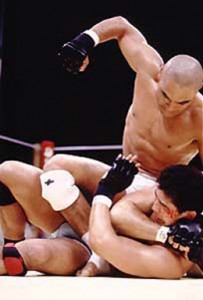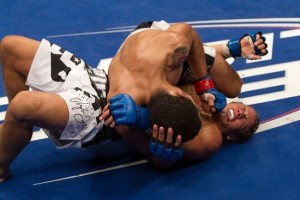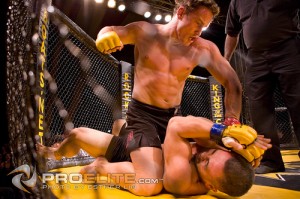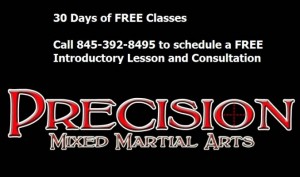“Ground and pound”. To the lay person this phrase means little, but to the initiated fan of modern day Mixed Martial Arts this is a term which has become quite well known in recent years, much to the credit of color commentators for the Ultimate Fighting Championship like Joe Rogan and Mike Goldberg amongst others. But what exactly is “ground and pound”? Most MMA fans who have never trained with actual fighters or who only watch the sport casually will give answers that are not really satisfactory. The most common is that “ground and pound” is a style of striking an opponent on the ground in MMA, with the emphasis usually being on the methods used by the fighter in top position to strike the bottom fighter. While this statement is generally correct it does not truly do justice to the skill which many top fighters call their number one method for attaining victory. As anyone who has trained with a skilled Pro MMA fighter knows, “ground and pound” has every bit as many nuances as submission grappling, takedowns or stand up striking. Many people with limited training believe that there is little technique to striking on the ground and that once a fighter achieves a takedown he need only reign down punches or elbows until the referee steps in. However, “ground and pound” is a skill in itself and simply “swinging away” on a downed opponent with little regard to technique is a good way to get submitted or swept by an opponent with a good Jiu-Jitsu game. In this article I will outline four different “ground and pound” techniques which have been used by different fighters in high level MMA fights and explain what makes these techniques so effective.
There is no more fitting way to begin an article on the skill of ground-striking in MMA than to start with the man often quoted as “the godfather of Ground and Pound”, Mark “the Hammer” Coleman. Coleman began his MMA career back in 1996 at UFC 10, the early days of Mixed Martial Arts when the sport had yet to be regulated under the “Unified Rules”. Coming from a wrestling background and having been a former NCAA champion, the 6’1, 255lbs bruiser took to fighting like a fish to water. In those days Royce Gracie had already established the value of ground grappling and Brazilian Jiu-Jitsu in MMA, and this is what truly paved the way for wrestlers, cluing them in to the fact that taking the opponent down and finishing them on the ground was a legitimate method for winning a contest. However, Royce had usually won his fights by using submission holds such as chokes and armlocks, rather than bludgeoning the opponent into defeat with punches, hammerfists, knees and elbows. Lacking the submission techniques available to BJJ artists but having every bit as much knowledge of ground positioning, Coleman was perhaps the first Mixed Martial Artist to routinely win fights simply by taking his opponents down and striking them until a referee either stepped in or they were rendered unconscious. Coleman had many methods for doing this, but one that I am going to look at in particular is what I will refer to as the “head in face” technique. This is one of the primary techniques which “The Hammer” used to win the most important fight in his career, his victory over Igor Vovchanchin in the “Pride Grand Prix 2000 finals” which led to his becoming the first ever Pride HW tournament champion. In essence this technique is quite simple, and yet devastatingly effective, and it is based on a few important principles that anyone must understand in order to recognize what makes for an effective “ground and pound” tactic. In this fight, Coleman made used of the “head in face technique” by standing in Igor’s full guard, then driving his forehead into his face and from there, punching in succession to the body, followed by single shots to the head.
Now, there are four important principles to ground and pound which one must understand if they are to separate a truly superior “gn’p” technique from simply striking a grounded opponent with reckless abandon. These principles are 1) controlling the arms 2) controlling the hips 3) controlling the head and 4) mixing up one’s strikes. Anyone who studies the art of Brazilian Jiu-Jitsu knows that controlling the hips and the head make a grounded opponent nearly helpless, and this same principle applies to wrestling and “ground and pound”. If an opponent does not have free range of motion with his head then his hip movement is going to be very limited and likewise if he does not have full movement of his hips then his head movement will probably not amount to much. Let me explain more clearly. All bodily motion is dependent upon movement of the spine, which goes as far up as the back of the neck and base of the head, and as far down as the tailbone, which is parallel to the hips at the front of the body. The two points of the body where the spine provides its greatest function are at its top and bottom, in other words, the neck/head area, and the hip/lower back area. If a grappler controls one of these two points he has a good deal of control over his opponent. If he controls both his opponent’s mobility is practically null as he has isolated his spine at both of its key points and this will make strikes very difficult to defend against. This is essentially how control of hip and head movement makes for an effective “gnp” technique.
On the other hand, controlling an opponent’s arms is important because you take away his main tools of offense and most importantly, his greatest method of defense. Controlling one of your opponent’s arms is often enough to prevent him from escaping or countering most forms of “ground and pound”, while controlling both of them makes his ability to counter or escape even more difficult, granted of course that the aggressor has some sort of head or hip control.
Finally, mixing up strikes makes for an effective “ground and pound” tactic because the opponent never really knows what to expect. This means directing blows to different parts of the body, head and even limbs, as well as using different types of strikes such as hammerfists, downward elbows, diagonal elbows and straight and looping punches.
With Mark Coleman’s “head in face” attack on Igor Vovchanchin, he made good use of the first two and the fourth principles. He controlled Igor’s head very well, which in turn allowed him to control his hips, and he mixed up his strikes to the body and head. What Coleman did in this fight was to essentially stand up in Igor’s full guard and drive his head directly into Igor’s face, making his own head and neck a fifth point of contact with the ground so that he could base off of it and throw his punches with full power without sacrificing his balance. With his feet planted and his hips above his opponents’, the bottom man’s hips were also limited in their mobility. In this particular situation, since Igor could not free his head his spine and body as a whole were isolated and his guard rendered quite ineffective. The placement of Coleman’s forehead in Igor’s face provided two other special advantages, in that it limited Igor’s view of the strikes coming at him and also caused him quite a bit of discomfort. Coleman also directed his strikes to different areas, generally throwing several times to the body and once or twice to the head in succession. As such, Igor was less capable of guessing where the strikes would land next, and thus had a more difficult time defending. This is a technique which Coleman’s protégé Kevin Randleman would also later use with great success in his fighting career.

Rickson Gracie doing the gift wrap
However, an even more effective “ground and pound” tactic than Coleman’s “head in face technique” is the mounted “gift wrap” which the great Rickson Gracie used to defeat Masakatsu Funaki back in 2000. The Gracie family is well known for introducing Brazilian Jiu-Jitsu to the world, but their style of ground fighting is not only effective for submissions, it is also effective for striking as Rickson proved in this fight. Now it is important to note that the most significant aspect of Rickson’s “gift wrap” on Funaki is not the trapping of his arm, but rather, the mount position itself. When a grappler passes his opponents’ guard and is able to mount him he has complete control over his opponents’ hips because his entire body is positioned above them. As such, the opponent’s legs have been taken out of the equation and his upper body has been isolated. He does, however, still have movement of his head and the top portion of his spine, but as we will see Rickson’s technique later prevents this. In this fight, after weakening Funaki with some shots from mount, he grips Funaki’s right wrist with his right hand, while reaching under Funaki’s head with left arm. Following this, Rickson feeds Funaki’s right wrist to his own left hand which is underneath Masakatsu’s head. This results in Rickson being mounted on Funaki while the latter’s right arm is completely wrapped around his own head, leaving him with only one arm to defend against Rickson’s strikes. Not only is Funaki’s right arm now trapped, but his head is also held firmly in place by his own arm and his hips are being completely controlled by Rickson’s mount. Goals 1, 2 and 3 of our “gnp” outline have now been met, and Funaki has no way to defend himself since almost his entire body is being controlled. This is another outstanding “ground and pound” technique which works well for MMA.

The Mounted Crucifix
The third “ground and pound” position we will discuss has become quite popular in Mixed Martial Arts today and is generally referred to as “the side mounted crucifix”. This move has a number of variations and has been used very successfully by a number of fighters, most notably Jon Jones in his UFC Live 2 win over Vladimir Matyushenko and Roy Nelson in his win over Kimbo Slice on “The Ultimate Fighter” Season 10. Much like Rickson’s mounted “gift wrap”, the most important component of this technique is first having a dominant position, in this case side mount. Once sidemounted, the top opponent is past the bottom man’s hips much like a mounted opponent would be, except that in this case he has his weight distributed sidewise across his opponent’s chest and abdomen rather than being directly on top of him as he would be when mounted. From this position, both of the opponent’s arms are tied up with the top man having one arm free to punch or elbow his opponent’s head. This technique covers points 1, 2 and 3 of our “ground and pound” index. First, not only one but both of the opponent’s arms are trapped. Second, the hips are isolated in the sense that the guard has been passed and the legs cannot be used for much and the weight distribution of the top opponent makes hip movement difficult for the bottom man. Finally, with both shoulders and hips pinned to the mat and a large body across the bottom man’s chest, the defender’s head has fairly little mobility as well. The position can be made more effective by mixing up one’s strikes and Jones proved in his fight that it is possible to finish an opponent from here with elbows while Nelson proved in his that it is equally possible to dominate by punching with the free hand.
The final “ground and pound” position that I would like to discuss in this article is not usually recognized as such because it is done from a bottom position, but I would personally consider it every bit as valid as many done from top control and this is the “triangle position” from bottom guard. Most people see the triangle as a submission only due to its ability to cut off the blood to the brain, causing the opponent to either tap out or pass out. However, as Anderson Silva proved in his victory over Travis Lutter at UFC 67, this can also be a dominant position from which to land multiple short elbow strikes which in this case resulted in a submission not from the choke, but from the strikes being delivered. Generally, the term “ground and pound” seems to be reserved for striking techniques delivered by the top fighter to the bottom fighter, and the reason for this is most likely because strikes delivered from on top tend to have more weight and force behind them. Usually ending a fight with strikes from the bottom is difficult to do, unless, of course, it abides by enough of the 4 rules of our “ground and pound” index, like the triangle does. First, it is important to note that the guard position is the only bottom position capable of being considered dominant because the bottom man’s legs do partially shut off full movement of the top man’s hips. Because the bottom guard player has his ankles positioned above the hips of the top man, the top fighter cannot advance further to fully isolate the bottom man’s hips. This is the first key to why the triangle can be considered a dominant position despite being done from on bottom. The second reason is that one of the top opponent’s arms is taken out of the equation by the unique positioning of the bottom man, and the other arm is trapped across the bottom man’s chest, making it difficult for him to defend against strikes which was another key to successful “gn’p” that we mentioned. Finally, the most important aspect of why the “triangle position” is a dominant angle for “gnp” is because it exercises maximum head control. The top opponent’s head is being completely controlled by the legs and arms of the bottom man. As such, the top point of his spine is isolated and his mobility is greatly lessened. In the case of the Anderson/Lutter fight, Anderson had such a good triangle sunk in that he was able to deliver downward elbow strikes until the ref stepped in. As can be seen, if one thinks outside of the box and utilizes enough of the principles of the “ground and pound” index, it is possible to stop a fight with strikes even from a bottom position.
Clearly “ground and pound” techniques are not effective because of top position alone, they are dependent upon a number of principles being used effectively. The Mark Coleman/Igor Vovchanchin fight is an excellent example of how unique head control can be used to create enough pressure from top guard to threaten an opponent. The Rickson Gracie/Funaki fight is an example of how head and arm control can be obtained simultaneously from top mount leaving the opponent with no method of defense from strikes. Jones’ and Nelson’s “sidemounted crucifixes” are examples of how both arms of the bottom man can be trapped simultaneously leaving him vulnerable. Finally, the example of Anderson Silva’s triangle on Travis Lutter shows that if proper head control is utilized even a bottom position can give a fighter enough power to stop a fight with successive blows. Next time you watch MMA and you see strikes being thrown on the ground I suggest that you pay attention to which of the four points from our “ground and pound index” are being applied, and take note of what the aggressor could be doing to make his ground striking more effective. Knowledge of “ground and pound” techniques and the principles behind them will enhance your enjoyment as a Mixed Martial Arts’ viewer just as much as it can increase a fighter’s effectiveness in the ring.
Jamey Bazes is a Hudson Valley martial arts practitioner holding a Brazilian Jiu-Jitsu brown belt with over 15 years of competition experience earning over 100 tournament victories. He also holds a Masters of Arts Degree in English from SUNY New Paltz with a focus on the English Romantic poets.








